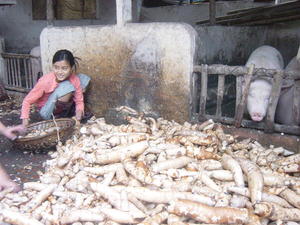- Animal health
- Animal Nutrition
- Genetic and Biodiversity
- Environment and natural resources protection
- Socio-economy in pig production sector
- Quality and food safety
- Animal husbandry and sustainable practices
- Rural Development
Agronomic evaluation of cassava
Agronomic evaluation of cassava ( Manihot esculenta Crantz) cultivated in the Sinú Valley, Colombia
Abstract
Nowadays cassava forageis a resource of great interest for utilization in animal feeding, due to the high production and to the protein content in the leaves. Moreover, there are some questions about which is the appropriate agronomic management for the crop as forage. For this reason, d an experimental area was established in transition zone between humid forest and tropical dry forest, on soils with good fertility. The agronomic performance was evaluated during the establishment period and in two production cycles, using the cassava variety CG1141-1. Three sowing systems were compared: inclined stakes of 15 cm (TS), continuous row with stakes of 15 cm (CS1) and continuous row with stakes of 45 cm (CS2). During the establishment period the number of shoots were evaluated sprouts n a linear meter and the height of the plants at 15, 30, 45 ad 60 days. During the production period the evaluation was: the number of plants /m, the production of forage, the height and the proportion of the different fractions of the plants in four ages of cuttinng (75, 85, 95 and 105 days); during two production periods. The design was a randomized split plot (DCR) with, with three repetitions. The main plots were the sowing system and the split plots the age of the plants at the time of measurement.
There were significant effects of both sowing system and age, and in the interaction system*age for the number of plants during the establishment period; showing a general decrease with increasing age especially for the TS system. The TS sowing system had a higher number of plants per metre (10.5), compared with 7.3 and 6.0 for CS1 and CS2, respectively. The plant height increased with the age, observing means of 8.49, 24.3, 60.7 and 115 cm at 15, 30, 45 and 60 days; the sowing system had no significant effect on this variable.
During the production period, the sowing system had no effect on the evaluated variables. On the contrary, the age influenced significantly all the variables except for the number of plants per metre. The means of production of green forage (GF) and dry matter (DM) were 19.5 and 4.01, 25.7 and 5.99; 29.6 and 6.34; 25.8 and 6.25 toneladasnes/ha at 75, 85, 95 and 105 days of cutting, respectively. During the first production period the production of DM and GF increased in linearly, whereas during the second period there was a decrease in the production after 95 days. The number of plants per linear metre was not affected by the sowing system or the age, with a mean of 8.23 plants/m, which corresponded to a density of 109733 plants/ha. The proportion of stems increased, whereas the proportion of leaves and petioles decreased when the age of cutting was increased. The mean values observed during the two production cycles were proportion of stems (DM basis) 38.7% at 75 days and 50.2% at 105 days; the mean values for leaves were 45.2 % at 75 days and 37.4% at 105 days. Values for petioles were 6.0% at 75 days and 12.4% at 105 days.
Key words: Continuous rows, DM yield, forage production, harvest interval, height, inclined stems, sowing system
For further information
Comments
CIRAD © 2007 (All rights reserved) - Disclaimer stating - Page updated : 22/01/2008

Bolívar D M y Molina S J 2007: Evaluación agronómica de la yuca ( Manihot esculenta Crantz) cultivada en el Valle del Sinú, Colombia. Livestock Research for Rural Development. Volume 19, Article #182. Retrieved printDate()January 22, 2008, from http://www.cipav.org.co/lrrd/lrrd19/12/boli19182.htm